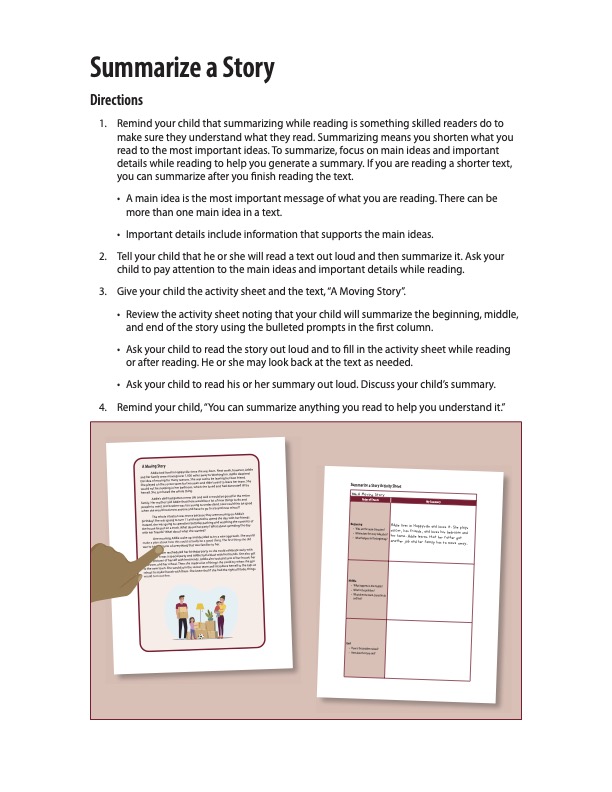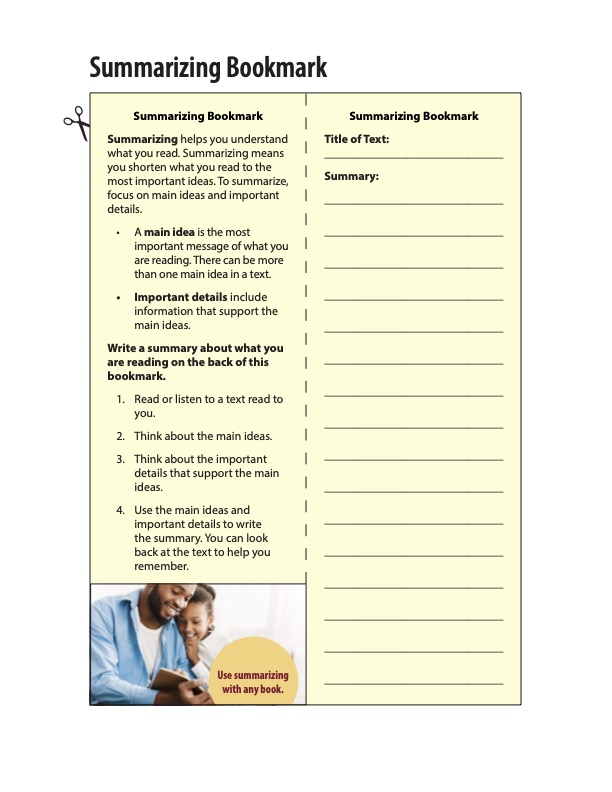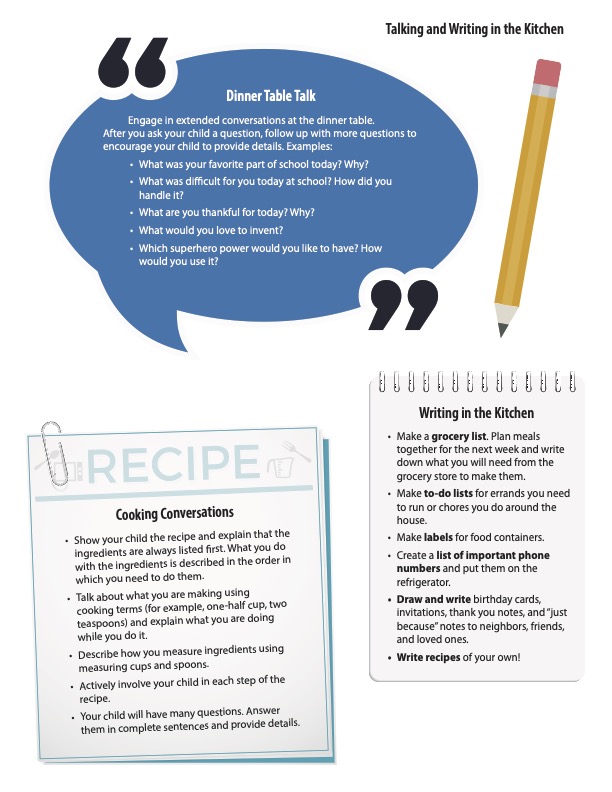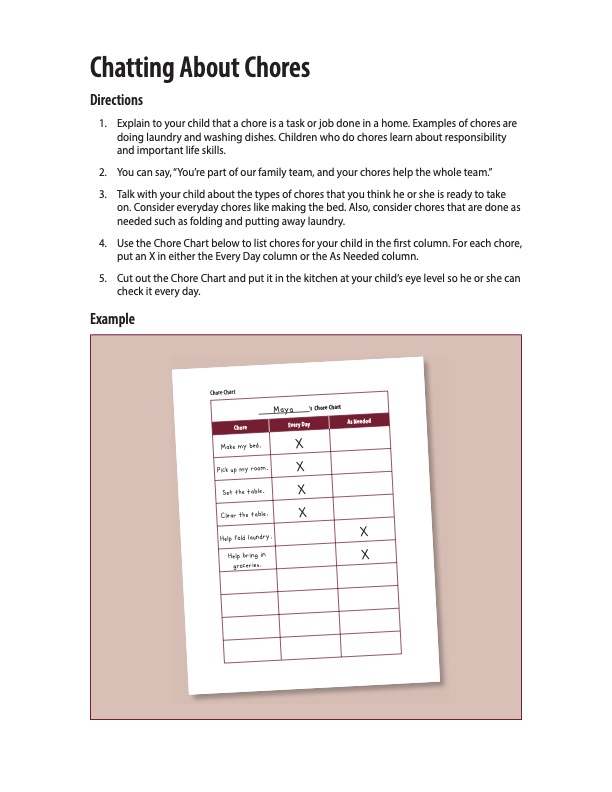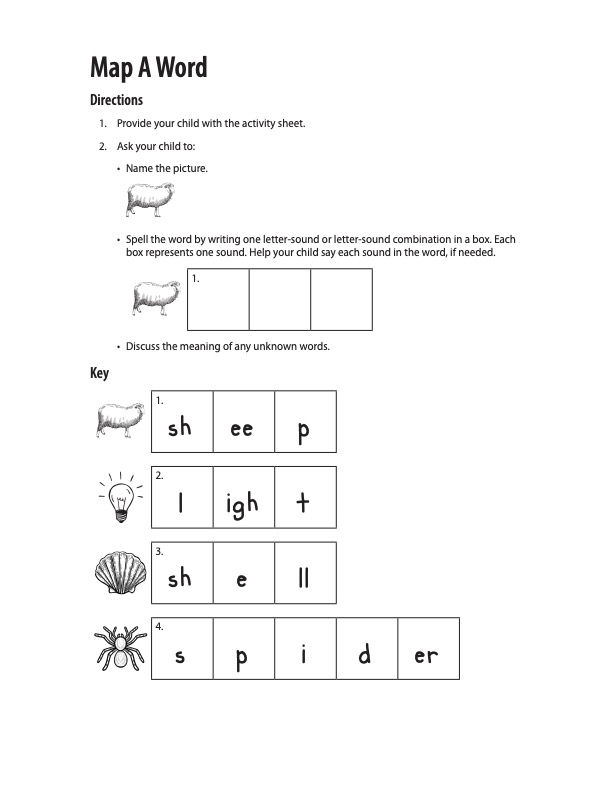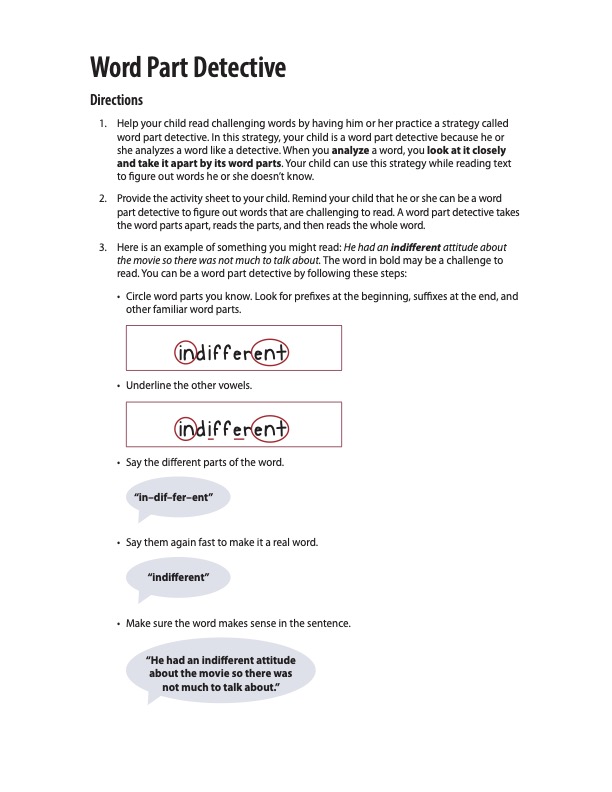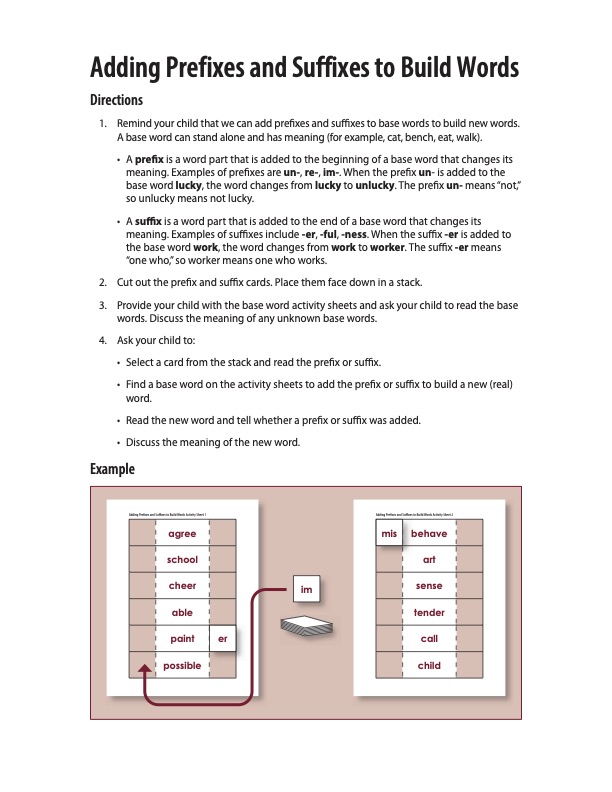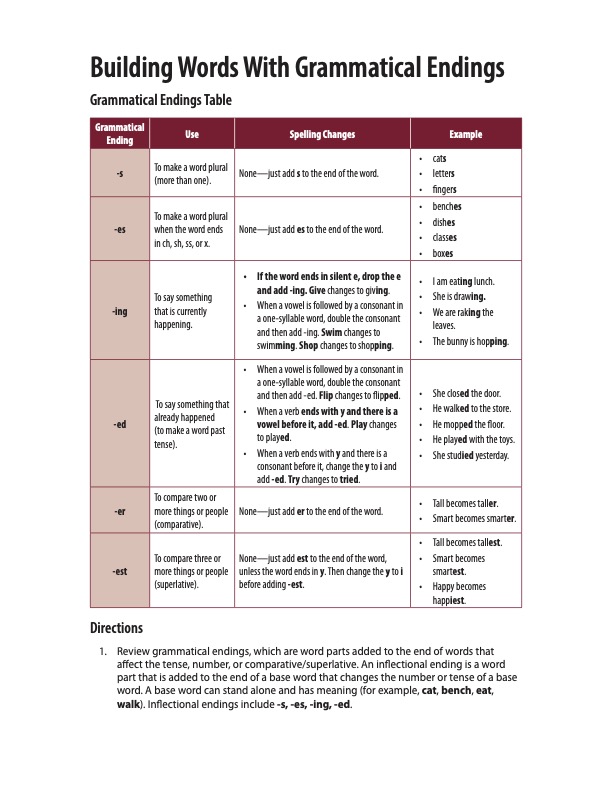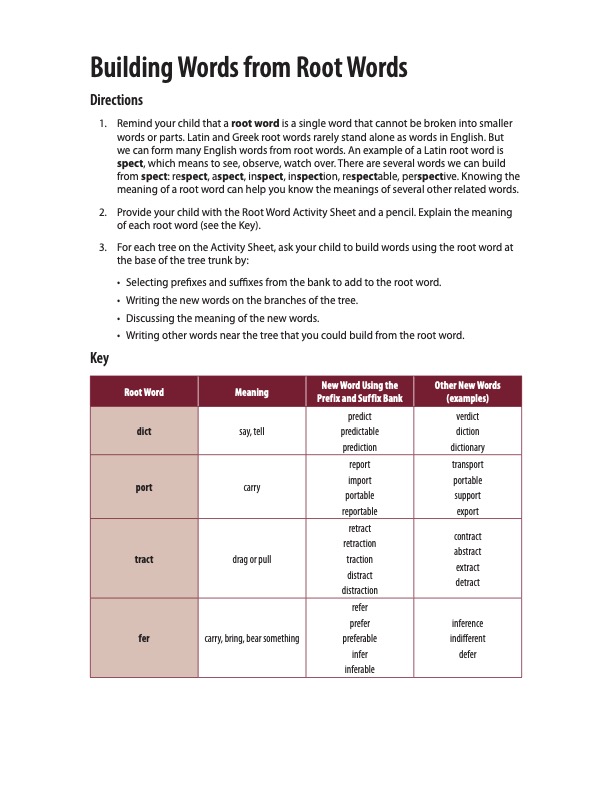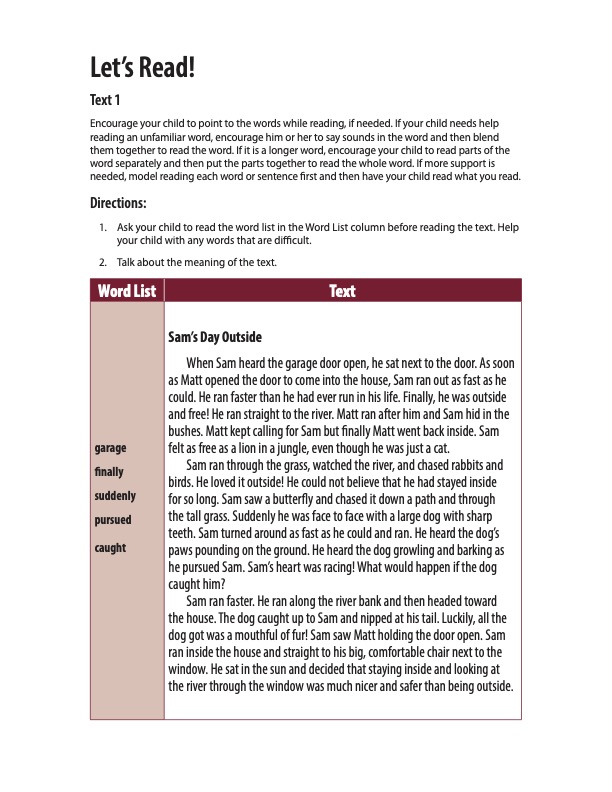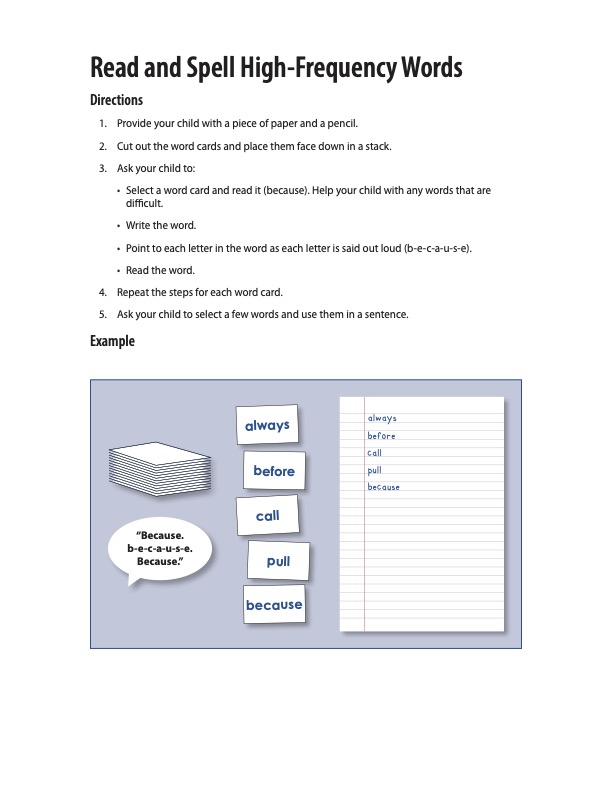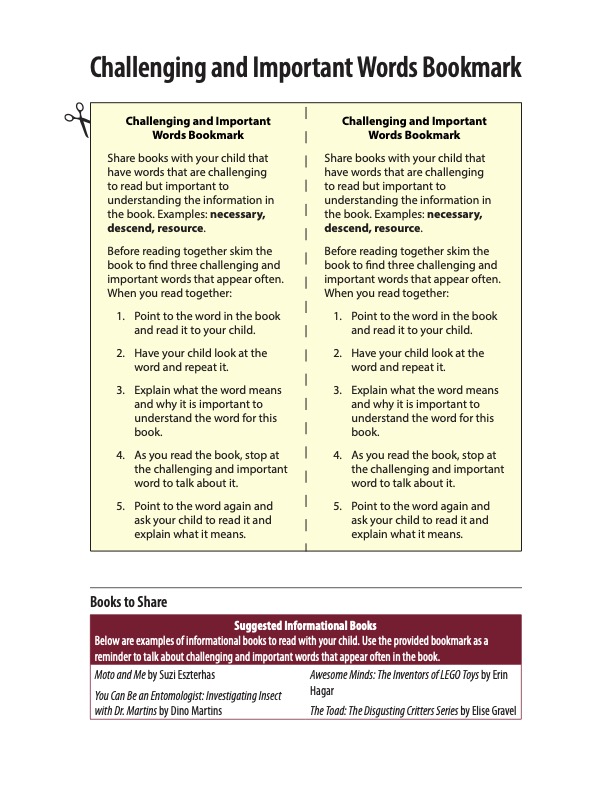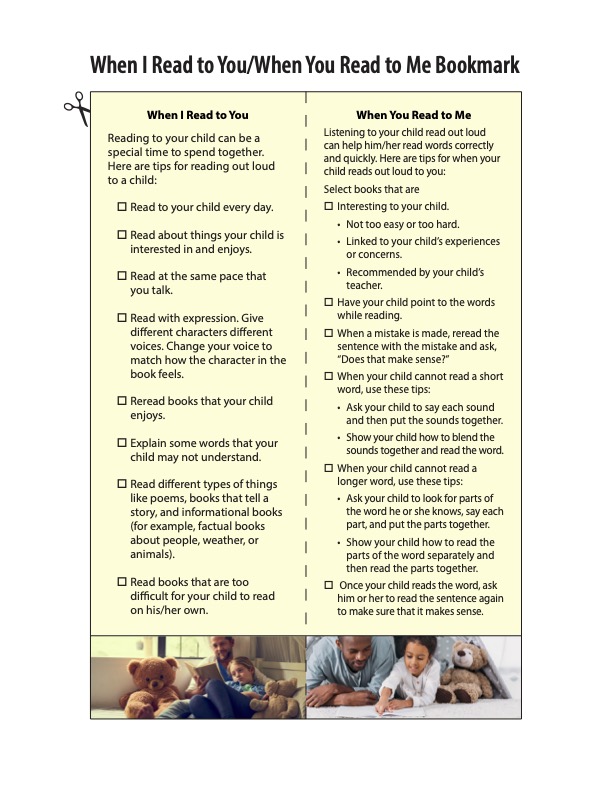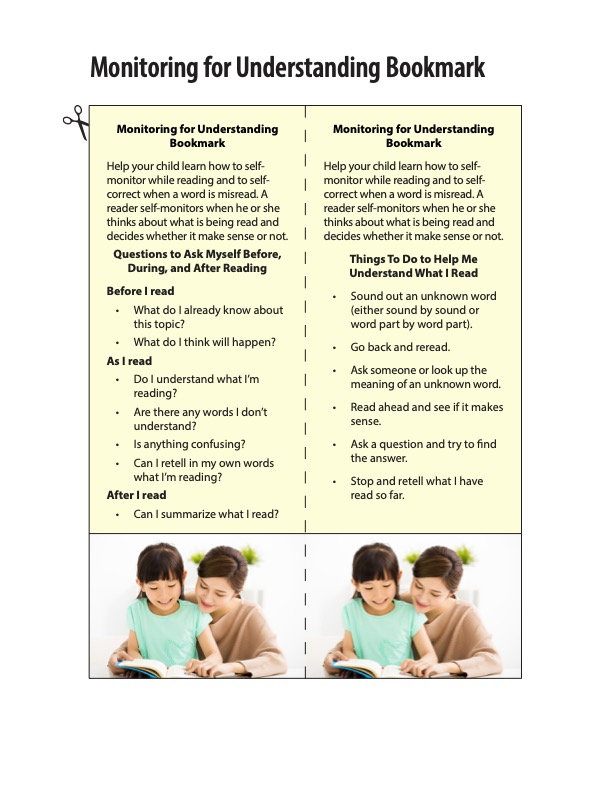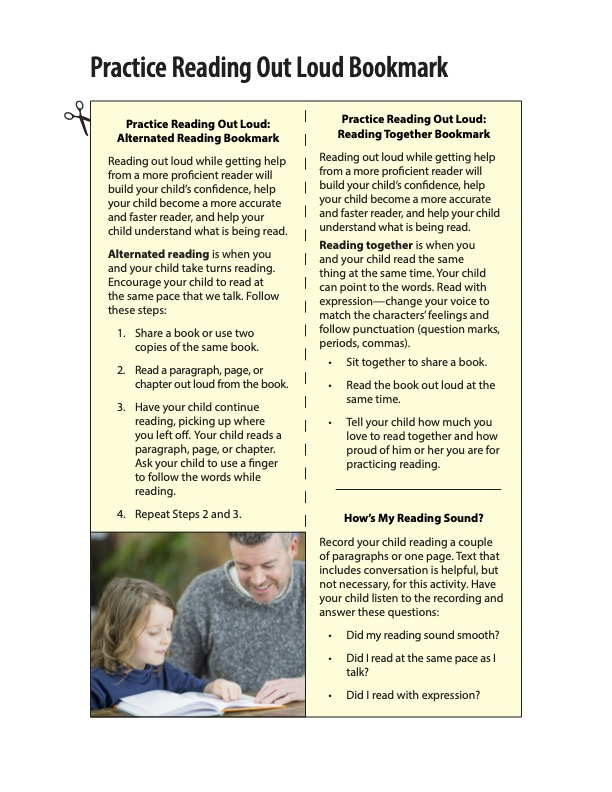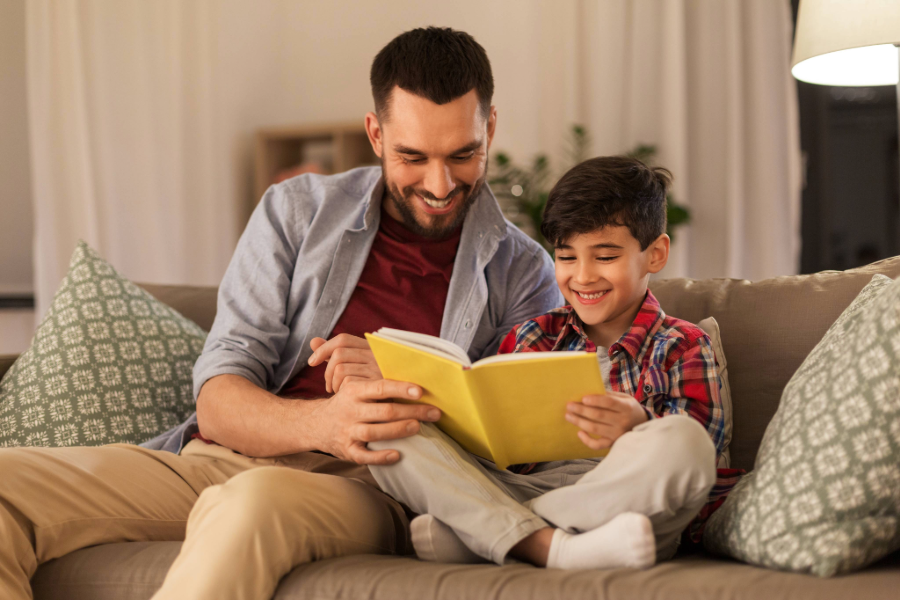
These activities provide families with information about how to support children as they practice foundational reading skills at home.
Learning to read begins at home through everyday parent-child interactions, long before children attend school. Your continued support of literacy development throughout elementary school positively affects your child's reading ability.
These Family Activities include easy-to-follow plans to help you support your child's foundational reading skills at home. Materials needed for each Family Activity, such as letter cards, are included. They begin with simpler activities and progress to more difficult ones. You may want to start with the first activity and move to the next when you notice that your child has a firm understanding of the content from that activity. We encourage you to select appropriate activities for your child, and free feel to set aside anything that seems too difficult. The goal is to engage your child in activities that promote learning in a positive environment, not to induce frustration. The activities should be completed with your child frequently, with patience, and with positive feedback. Using the activities at home will be a fun way to spend family time together!
Third Grade: Developing Language
Talking While You Read
Expose your child to the formal language that is common in books and in school.
Having a conversation about a book will develop your child's vocabulary and build knowledge about the topic of that book. Whether you are reading a fairy tale, a picture book, an informational book, or any other text, you can engage in a discussion as you enjoy reading together.
It is best to choose books about topics which are interesting to your child. You can read books from your home or borrow a book from your child's classroom library, school library, or the public library. You can also access books on laptop computers, tablets, digital reading devices, and smartphones. Websites such as Project Gutenberg provide free access to books and mobile formats especially for smartphones. Don't forget to look through your smartphone's app store for free apps containing books for children.
Incredible Inferences
Key Points About the Video
- Mom describes what an inference is before they play the game.
- Mom asks kids to show evidence from the text to support their inference.
- Mom and kids have fun playing the game.
Incredible Inferences
Help your child make inferences by using evidence from what he or she reads to make a logical conclusion.
Summarize a Story
Key Points About the Video
- Mom and daughter discuss what a main idea is before beginning the activity.
- Daughter reads the beginning of the story, writes a summary of it, and then discusses the summary with Mom. This is repeated with the middle and the end of the story.
- Mom discusses the meanings of words that may be challenging to understand (despise).
Summarize a Story
Help your child summarize what he or she reads to support comprehension.
Summarizing Bookmark
Use this bookmark to engage your child in conversation about the main ideas and details of what you read together.
Books to Share
Here is a list of suggested book to practice summarizing. Although, you can summarize anything you read. Take turns reading or listen to your child read. Stop after a chapter, if a long book, and ask your child to tell you the main ideas and important details. You can do this at the end of a short book.
- Owen and Mzee: The True Story of a Remarkable Friendship by Isabella Hatkoff, Craig Hatkoff, Paula Kahumbu
- Goose and Duck by Jean Craighead George
- Koala Lou by Mem Fox
- The Tiny Seed by Eric Carle
- Ice Cream Elisha Cooper
Supporting Oral Language and Vocabulary Development
Oral language is the way we communicate with others through speaking and listening. Vocabulary knowledge is a crucial part of oral language and includes understanding the meaning of words, how to use them, and how to pronounce them.
Oral language practice will help your child expand his or her vocabulary. Children with strong oral language skills and larger vocabularies typically become better readers. The best ways to give your child a strong foundation for learning to read are to read to, talk to, and listen to your child every day. Talk about people you know, places you go, and experiences you have together. Writing with your child also helps with oral language development.
- Ask questions that require more than a yes or no answer. For example, instead of asking, "Did you have a good day?" ask, "What was your favorite part of school today?" Continue to ask questions about your child's response. If the answer was "Recess," ask, "Who did you play with?" "What did you do?" "How do you play that game?"
- When you speak with your child, model speaking in complete sentences and providing details. Use the words your child says and expand on them. For example, if your child points to a car and says, "Yellow car!" say, "That is a bright yellow car that is moving quickly! Where do you think that person is going?"
Dinner Table Talk
Key Points About the Video
- Adults listen to daughters and ask open-ended questions to extend the conversation.
- Family has fun discussing what they would invent and their favorite super power.
- Mom ensures that all family members have opportunities to participate in the conversation by asking each family member the same questions.
Baking Conversations
Key Points About the Video
- Caretaker describes how recipes are organized (ingredients and steps).
- Child reads the steps of the recipe and is actively involved in every step of the recipe.
- Caretakes uses words (for example, chill, dough, fluffy, batter, scoop) to describe what they are doing.
- Caretake describes the reason why they are doing specific things to deepen child's understanding of concepts (for example, the science of baking, why make a test batch, why place cookies near center of baking sheet).
Talking and Writing in the Kitchen
Use these questions, activities, and conversation starters to have fun while you talk and write in the kitchen.
Chatting About Chores
Key Points About the Video
- Mom and daughter discuss what chores are and why they are important.
- Mom talks about the meaning of responsibility.
- Mom is positive and has daughter determine her own chores, state why each chore is important, and write them on the chore chart.
Chatting About Chores
Use this activity to talk about and make a list of chores your child can do.
Synonyms and Antonyms
Key Points About the Video
- Dad makes sure son knows what a synonym and antonym are by having him give examples before beginning the activity.
- Dad explains meanings of words that may be unfamiliar (for example, courteous). Dad uses words in sentences that his son can relate to (for example, "Your sister comes into your room and ruins your Legos.")
- Dad asks son to use words in sentences to make sure he understands the meaning of each word.
Synonyms and Antonyms
Help your child practice identifying and writing synonyms and antonyms.
Talk About Words
Key Points About the Video
- Mom describes the meanings of the antonyms (opposites): stranger, relative.
- Mom relates the meanings of words to her daughter's experiences.
- Mom asks questions to prompt daughter to describe why she decides to place words where she does on the continuum.
- Mom helps daughter read unfamiliar words by giving her cues. For example, "That's a long a." (stranger) And, "Sound it out." (sob).
- Mom asks daughter to read all the words after they are placed on the continuum for another opportunity to practice reading.
Talk About Words
Deepen your child's understanding of related words and help enhance your child's vocabulary.
Third Grade: Linking Sounds to Letters
Linking Sounds to Letters
Help your child link sounds in speech to letters in print.
Linking individual letter sounds to letters is typically achieved by second grade. However, if a child needs practice with pulling apart and putting together sounds in spoken words and linking sounds to letters in print (M says /m/), please visit Supporting Your Child's Reading at Home, First Grade: Linking Sounds to Letters.
Third Grade: Blending Letters, Recognizing and Reading Words
Blending to Read Words
Help your child blend letters to read words and recognize common word parts and words, and encourage them to write words.
Blending is the ability to put sounds together to read a word. To read a word, children must know the sounds the letters represent in the word and be able to blend those sounds to pronounce the correct word. For example, after children know the letter sounds /f/ for f, /a/ for a, and /n/ for n, they learn to blend those sounds together to read the whole word. When they see the word fan, they are able to say,"/f/, /a/, /n/, fan." By the time your child reaches third grade, he or she should be able to read many words automatically, without having to think about blending the letter sounds. However, when your child encounters an unknown word, blending together the individual sounds of the letters can help him or her figure out the word.
Map A Word
Key Points About the Video
- Mom describes that each box represents one sound. So, there may be more than one letter in each box.
- Mom says encourages her son to say each sound in the word to help him spell the words (for example, /sh/ /ee/ /p/, /l/ /igh/ /t/, /sh/ /e/ /ll/.
- Mom is patient and encouraging.
Map A Word
Help your child spell and read words with different letter-sound combinations.
How Many Words?
Key Points About the Video
- Mom has daughter spell words with letter cards and write them on the board for another opportunity to practice.
- Mom gives hints to determine which words to spell (for example, "Sometimes I like to make the ending of the word, -at, and then change the beginning letter to see how many words we can spell.")
- Mom describes the meaning of words that may be unfamiliar (for example, raw).
How Many Words?
Help your child build, blend, and read words using letter cards.
Building Words With r-Controlled Vowels
Key Points About the Video
- Mom makes sure son knows what r-controlled vowels (ar, er, ir, or, ur) are before beginning the activity.
- Mom uses words in sentences and engages son in discussions about the meanings of words (for example, march, stern, storm).
- Mom prompts son by saying individual sounds in words to help him spell the words (for example, "Which two letters say /ch/?").
Building Words With r-Controlled Vowels: ar, er, ur, or, ir
Help your child read and spell words with r-controlled vowels (ar, er, ir, or, ur).
Common Word Parts
Understanding common word parts like base words, prefixes, and suffixes will help children break words into smaller, meaningful word parts, which can help them read, write, and understand more challenging words.
The word help is called a base word because it can stand alone and has meaning. It is also called a base word because we can add to it to change the word. For example, we can add the ending -ful, for the word helpful. When we add a word part to the end of a word, it is called a suffix. We can also add a word part to the beginning of a base word. When we add a word part to the beginning of a base word, it is called a prefix. For example, the prefix un- can be added to helpful to make the word unhelpful.
| Word | = | Prefix | + | Base Word | + | Suffix |
|---|---|---|---|---|---|---|
| Unhelpful | = | un | + | help | + | ful |
Word Part Detective
Key Points About the Video
- Mom explains how to be a word part detective. Mom shows her son how to analyze the first word (indifferent).
- With each word, Mom has her son do more and more of the work until he is analyzing words independently.
- If her son does not know the meaning of a word, Mom explains the meaning (unpleasing, identical, intermittently) to make sure her son understands each sentence.
- Mom is enthusiastic and encouraging.
Word Part Detective
Help your child read challenging words by having him or her practice a strategy called word part detective. Your child will look at a word and take it apart by its word parts to help him or her read the word.
Adding Prefixes and Suffixes to Build Words
Key Points About the Video
- Before beginning the activity, Dad makes sure his son knows that a prefix is added to the beginning of a word and a suffix is added to the end of a word.
- Dad has son read the list of base words to make sure he knows them.
- After a prefix or suffix is added to a word, Dad asks his son the meaning of the word or to use it in a sentence to make sure he understands the new word.
Adding Prefixes and Suffixes to Build Words
Help your child add prefixes and suffixes to base words.
Building Words With Grammatical Endings
Help your child use grammatical endings to build and read words.
Building Words from Root Words
Help your child add prefixes and suffixes to root words to build many words using the same root word.
Reading Words
Blending is the ability to put sounds together to read a word. For example, when children see the word soil, they are able to say, "/s/, /oi/, /l/, soil." There are many ways to support your child in reading words. For example, provide opportunities for your child to practice reading words in a list or on flashcards. It is also important for children to practice reading words in sentences and stories.
Let's Read!
Key Points About the Video
- Dad reminds his son to follow along with his finger as he reads.
- Dad models fluent reading (reading words correctly, at a conversational pace, and with expression) when it is his turn to read.
- Dad explains difficult words (pursue) and asks questions during and after reading to make sure his son understood what was read.
Let’s Read! Text 1
Help your child read words in a list and then read text that contains these words.
Let’s Read! Text 2
Help your child read words in a list and then read text that contains these words.
High-Frequency Words
High-frequency words are words that appear frequently in books. Examples of high-frequency words are again, every, know, could. It is important that children learn how to read high-frequency words automatically, correctly without hesitation. The more your child reads and writes high-frequency words, the better he or she will get at reading them automatically.
There are many activities that families can do to help their children read high-frequency automatically.
- Show your child the high-frequency word laugh. Have your child say the word, write the word, and then say the word again.
- Use the provided high-frequency word cards as flash cards and time your child as he or she reads a stack of them. You can place words that were challenging for your child in a separate pile, so you know which words need more practice. The goal is to read more words correctly in less time each time you engage in the activity.
Read and Spell High-Frequency Words
Key Points About the Video
- Dad explains high-frequency words and how they will complete the activity before they begin.
- For each word, the daughter reads it, writes it, spells it out loud, and reads it again.
- Dad has daughter say the whole sentence before she writes it.
Read and Spell High-Frequency Words
Help your child practice high-frequency words (about, laugh).
Challenging and Important Words
Just because a book contains challenging words, it doesn't mean that you can't read it with your child. Before reading a book with your child, skim it to see if there are any challenging and important words. For example, Tyrannosaurus rex would be considered challenging to read, but are important words in a book about dinosaurs. Words also may be challenging because the child has not learned the sound-spelling pattern contained in the word or the word contains irregular sound-spelling patterns as in the words resource or necessary. Select three such words that appear most frequently in the book. Introduce the words to your child before you read the book. Point to each word in the book and tell your child how to pronounce it and what it means. Ask your child to point to the word and say it. If there are too many challenging words, you can read the book aloud to your child rather than have him or her read it to you.
Challenging and Important Words Bookmark pt 2
Follow the steps on this bookmark to discuss challenging and important words with your child as you read books together.
Books to Share
A list of informational books to read with your child. Use the provided bookmark as a reminder to talk about challenging and important words that appear often in the book.
- Moto and Me by Suzi Eszterhas
- Awesome Minds: The Inventors of LEGO Toys by Erin Hagar
- You Can Be an Entomologist: Investigating Insect with Dr. Martins by Dino Martins
- The Toad: The Disgusting Critters Series by Elise Grave
Third Grade: Reading for Understanding
Accurate and Efficient Word Identification
Support your child in reading accurately, at a conversational pace, and with expression so they understand what they read.
As your child practices reading out loud, it is important to help him or her to read words correctly and quickly. When children can read words accurately and fairly quickly, they can focus their attention on understanding what they are reading instead of trying to identify each word.
There are two important things families can do to help their child read words correctly and quickly.
- Read out loud to your child every single day! Reading to your child can be a special time to spend together. It will show him or her that reading is important and fun! Reading aloud will help your child understand what reading should sound like, and provides a model of how to read words correctly, quickly, and with expression! Reading with the right expression means that you are talking like the characters in the book--your voice sounds excited when the character is excited or sad when the character is sad.
- Encourage and help your child as he or she reads out loud. You may need to help your child when she or he comes to a word that is difficult to read. You might provide a reminder by saying, "Let's say each part of this word and the put the parts together to read it." Any reminder that encourages your child to use what he or she already knows to figure out the word can be helpful.
As you read with your child, remember to be patient as reading is a skill that takes a lot of practice. Be sure to let your child know that you are proud of his or her progress! The support and encouragement you give your child will help him or her improve in reading.
When choosing books for your child to read out loud, select books that are of interest to your child, are not too easy or too hard, and are linked to his or her experiences or concerns. For instance, if your child is interested in animals or is afraid of the dark, it can be helpful to select books on those topics.
When You Read to Me (Dingoes at Dinnertime)
Key Points About the Video
- Mom provides hints on how to read unfamiliar words so her daughter can use the letter-sounds and the sound-spelling patterns she knows to read unfamiliar words (wasted, precious, whirlwind).
- Mom models reading words correctly.
- Mom has her daughter reread sentences that are challenging for extra practice.
When I Read to You (Because of Winn Dixie)
Key Points About the Video
- Mom reads words correctly, at a conversational pace, and with great expression!
- Mom asks questions once in a while to make sure her daughter understands the story.
When I Read to You When You Read to Me Bookmark
On one side of this bookmark are tips to use as you read out loud to your child. On the other side are tips for when your child reads out loud to you.
Books to Share
A list of suggested books that you can read to your child to model reading words correctly, at a conversational pace, and with expression. Although you can do these things with anything you read with your child.
- The One and Only Ivan by Katherine Applegate
- How Much is a Million? by David M. Schwartz
- Thank You, Mr. Falker by Patricia Polacco
- How to Train Your Dragon by Cressida Cowell
Recognizing Misread Words and Correcting Errors
Experienced readers know when their reading does not make sense because they have misread a word. Once they realize they misread a word, experienced readers can correct their mistake. Beginning readers don't always notice when they misread a word because they don't always pay attention to what they are reading. Therefore, it is important to show children how to recognize misread words when they read. A reader should think about what he or she is reading and decide whether it makes sense or not, that is, self-monitor. We also need to show children how to self-correct when they misread a word. Improving the ability to self-monitor and self-correct will help children understand what they read and become better readers.
Families can help children monitor what they read and make corrections when words are misread. As you read to your child, you can provide examples of how to recognize when words are misread by "thinking out loud." You can say things like, "That didn't make sense. I'm going to read that sentence again." When your child reads to you and misreads a word, ask her to stop and see if she can correct the error. If not, reread the sentence with the missed word exactly how your child read it and ask, "Did that make sense?" If your child does not self-correct, read the word and have her reread it. Then have her read the sentence correctly.
Self-Monitor Understanding and Self-Correct Word-Reading Errors (Goldie)
Key Points About the Video
- Mom asks her son questions about the topic of the book and to make a prediction before reading.
- Mom praises son for self-correcting words that he misreads.
- Mom asks questions to help her son summarize what he read to make sure he understood what he read.
Monitoring for Understanding Bookmark
On one side of this bookmark are questions your child can ask him or herself before, during, and after reading. On the other side of the bookmark are tips your child can use make sure he or she understands what is being read.
Books to Share
A list of suggested books for your child to read out loud to you while you help your child recognize and correct misread words.
- Because of Winn-Dixie by Kate DiCamillo
- Over and Under the Pond by Kate Messner
- The Puppy Place (Series) by Ellen Miles
- The Bravest Dog Ever: The True Story of Balto (Step-Into-Reading Series) by Natalie Standiford
- The Fantastic Mr. Fox by Roald Dahl
Oral Reading Practice
Oral reading practice is when children read out loud. It is very important that children in third grade have many opportunities for oral reading practice with a proficient reader that listens and offers help when needed. As children read out loud, they get better at reading words correctly, quickly, and with the right expression (fluently). Reading words quickly means reading them at the same pace in which we talk. When you read with the right expression, you understand what commas, periods, and question marks mean. Reading with expression shows that you understand what you read when you, for example, change your voice to be excited when a character is excited. When children read fluently, they can focus their attention on understanding what they read, rather than trying to figure out how to read the words. The more children practice reading out loud with support, the better readers they will become!
There are many ways to support your child in oral reading practice. You can alternate reading and read together.
- Alternated reading is when you and your child take turns reading a paragraph, page, or chapter out loud. You child continues reading, picking up where you left off.
- Reading together means you and your child read the same thing out loud at the same time. When you read at the same time, make sure your child follows along by pointing to each word. You can slow your pace of reading down a little when you read at the same time. Always offer positive encouragement and let your child know how proud you are because he or she is practicing reading.
The encouragement and support children receive as they read out loud will help them become more fluent and confident readers. Be patient as children learn to read and remind them often of how proud you are of them for practicing reading.
Practice Reading Out Loud (Afternoon on the Amazon)
Key Points About the Video
- Mom explains what a prologue is (an introduction to the book that tells what happened before chapter 1).
- Mom and son take turns reading so Mom can model fluent reading (reading correctly, at a conversational pace, and with expression).
- Mom provides her son tips on how to read with expression by reminding him what to do at periods, question marks, and explanation marks.
Practice Reading Out Loud Bookmark
Use this bookmark as a reminder of the importance of reading every day with your child. One side of the bookmark describes Alternated Reading and the other side describes Reading Together.
Books to Share
A list of suggested books for your child to read out loud as you use Alternated Reading and Reading Together.
- Where the Sidewalk Ends (poems) by Shel Silverstein
- Punctuation Celebration by Elsa Knight Bruno
- You Read to Me, I'll Read to You: Very Short Fables to Read Together by Mary Ann Hoberman
- Don't Let the Pigeon Drive the Bus! by Mo Willems
The Family Activities were excerpted from A Third Grade Teacher's Guide to Supporting Family Involvement in Foundational Reading Skills, which include Third Grade Videos.



